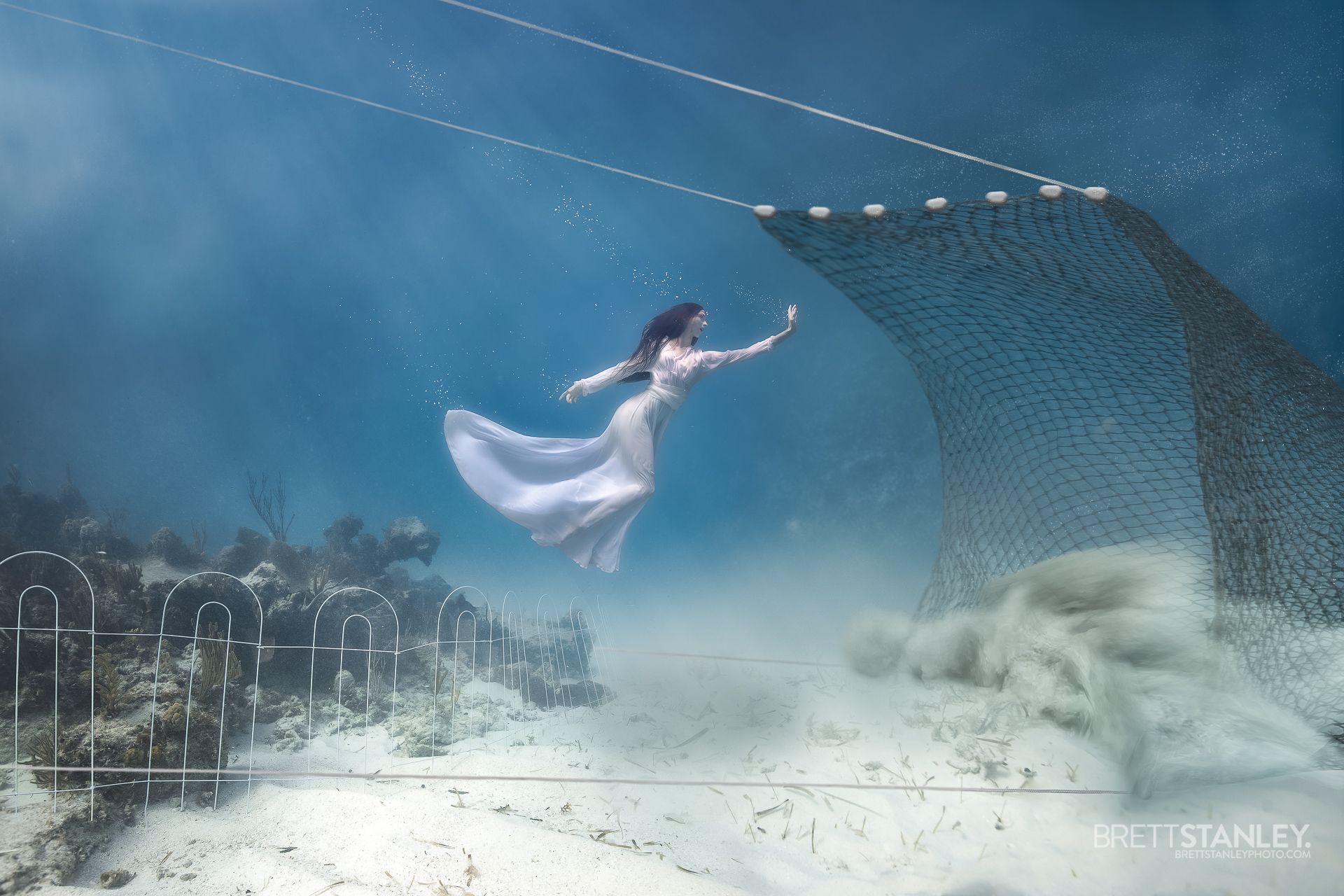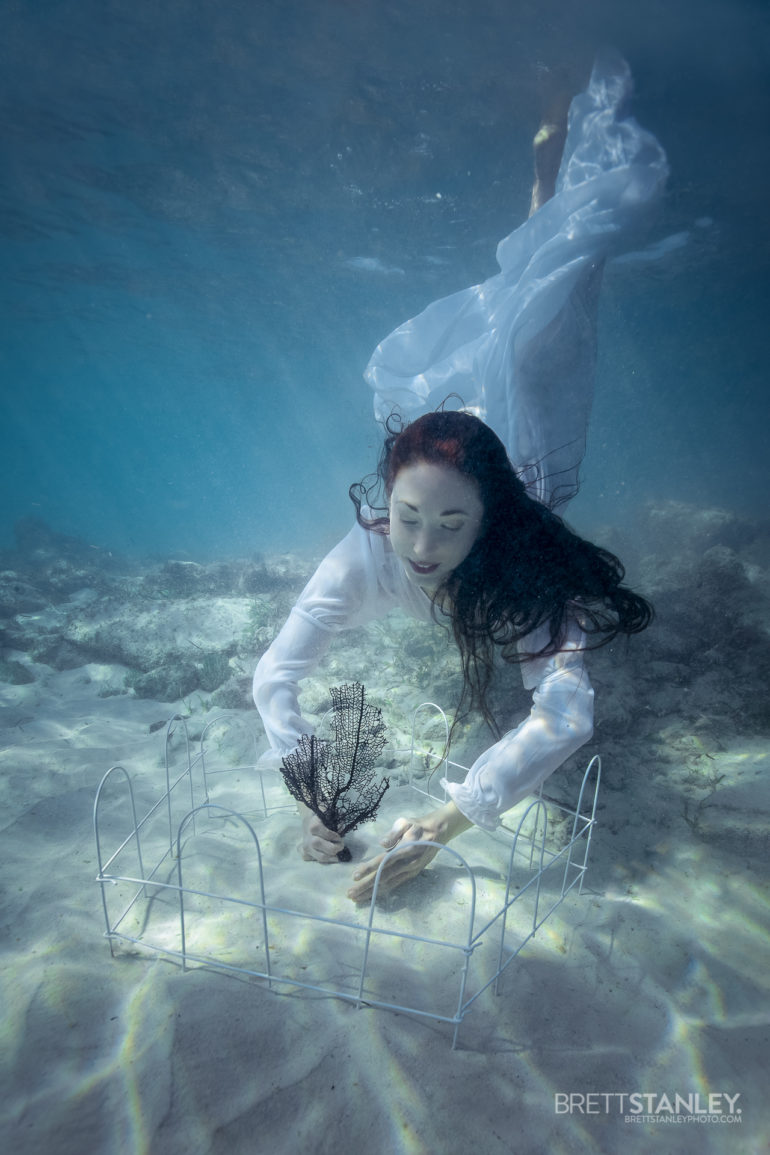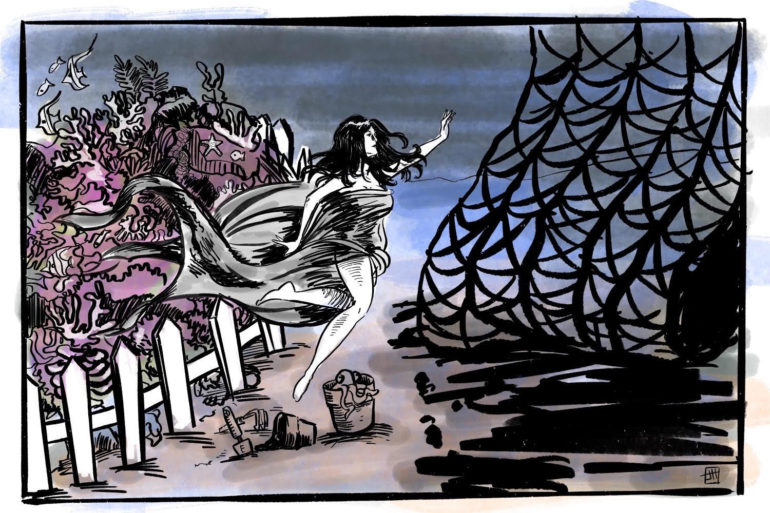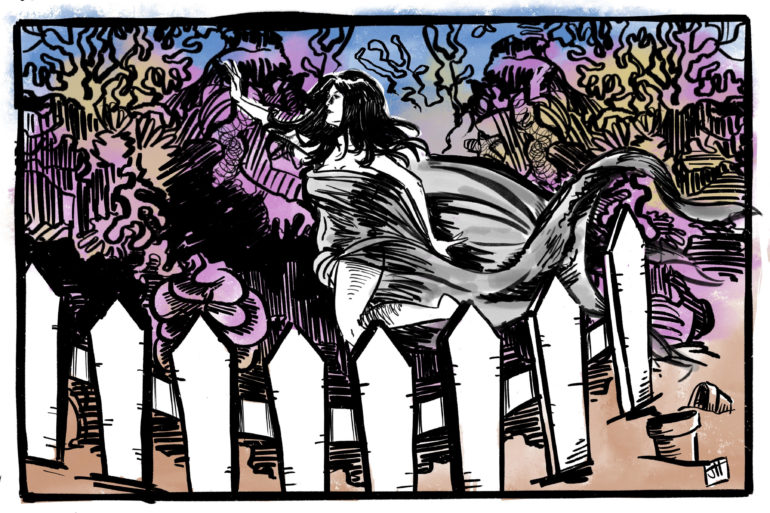All images by Brett Stanley with creative direction by Christine Ren. Used with permission.
“It’s becoming so hard, even with incredible imagery, to get messages to land with impact online.” says Christine Ren, who was both the model and provided creative direction for the Ocean Guardians project. “I won’t stop putting content online digitally, but digital-only is absolutely failing when it comes to conservation storytelling and even non-profit fundraising, in my opinion.” We’ve featured Christine’s work before on Silent Killers and Carbonated Ocean. Christine is passionate about the conservation of our oceans and uses art to get that message across. Specifically for Ocean Guardians, she tackled the issue of trawling. Like any creative who places specific elements in a scene to tell a story, her and photographer Brett Stanley collaborated on a photo series that does a great job of getting a message across. But as I talked about with Christine, we both think that the world needs to start doing more about this than sharing on social media.
Phoblographer: You’ve got an obvious message to deliver about bottom trawling, so when you went about teaming up with Brett to create these images, what was your creative vision and intent?
Christine: “Protect What’s Precious” is a narrative underwater photo campaign aimed at conveying how the creation of Marine-Protected Areas (MPAs) help safeguards the ocean from trawl nets that bulldoze the seafloor. I’d been wanting to tackle trawling for a long time now but in discussing with my underwater photography collaborator Brett Stanley, we knew it had to be staged on or around an actual coral reef which becomes much more costly than shooting in a local Los Angeles pool. Rebubble came to our aid in that regard though with a “Create Some Good” grant. I wanted to embody an ocean guardian standing off against one of these trawl nets coming in towards a reef. Brett suggested we try to ensure we had both “problem” and “solution” shots as well; particularly, using fences around the reef to convey the idea of coral reefs as gardens that should be protected. Fencing off areas of land, such as designating them as parks for non-development or clear-cutting, was something we wanted to directly carry over and convey as also a practice that works for the protection of underwater habitats.
Phoblographer: The video shows us a bit about the process of the shoot, but how many takes did you folks need to get the image that we see?
Christine: We had a pretty large team working on this, especially compared to my other shoots in the controlled environment of a pool where its really just me, a makeup artist and our photographer. There was a group of about 7 people on the actual shoot day out on the boat to pull this off. I pitched the idea to Redbubble for a “Create Some Good” grant, then directed and organized all the shoot details, but it was really the collaborative efforts of folks like Brett Stanley, Kristy Jessica, our videographer, Joe Hoddinot, our storyboard artist, and Shaun Osborne of Bahama Island Excursions and his safety diver team, that donated their boat, tanks and local knowledge on where to shoot that brought it all together. It was a very complex project to pull-off with a million moving pieces. I still can’t believe we brought it to life is such a beautiful way.
“Brett suggested we try to ensure we had both “problem” and “solution” shots as well; particularly, using fences around the reef to convey the idea of coral reefs as gardens that should be protected. Fencing off areas of land, such as designating them as parks for non-development or clear-cutting, was something we wanted to directly carry over and convey as also a practice that works for the protection of underwater habitats.”
Phoblographer: It doesn’t look like there is much Photoshop or compositing involved at all, is there?
Christine: With underwater work, there’s always some Photoshop work required for backscatter clean-up and some distortion that can happen with the lens and/or lighting. For this campaign, Brett shot it all in one shot underwater as well as me and the fenced off reef then the trawl net separately to give us more room to play with the placement of the elements in the final composition. Ultimately, in order to scale that trawl net large enough, Brett did stitch the shots together and also did a little Photoshop work on the net to make it feel more like it was moving along the seafloor. Everything was shot in situ underwater though. The fence and the reef are real and I was there next to them underwater, in the freezing cold water. We built and installed on the seafloor our best approximation to a trawl net as well.
Phoblographer: How long did this take to execute this project?
Christine: In late September 2018, after receiving the grant award from Redbubble to execute this concept I pitched, we were in a mad dash of pre-production for about 3 months before we had to shoot and deliver the entire campaign by early to mid-January for approval to post on Valentine’s Day. I have never so quickly brought one of these underwater imagery campaigns to bear, especially one on location in a destination I had to fly the entire team into. Having a budget to create with though made all the difference in terms of the narrative and final product. I was able to have lengthy conceptual discussions with Brett Stanley, our underwater photographer, that has a keen sense of what will resonate most clearly visually and not. After that, I was able to hire Joe Hoddinott, an underwater photographer in his own right but also a fantastic storyboard artist, to create mockup visuals of the final product. We quickly had to then squeeze in and schedule the entire team to get to the Bahamas in December and also find a local guide and private dive boat that would take us out within budget. Shaun Osborne of Bahama Island Excursions donated his boat, besides fuel, captain and safety costs, for us to use and without him, we couldn’t have pulled it off.
Phoblographer: What were some of the biggest challenges you encountered creating this campaign?
Christine: The challenges with this project were manyfold more than some of my previous work executed in the controlled environment of a pool. Pulling the shoot off within the budget was one of the largest challenges, and figuring out how we were going to build and install our mock-up trawl net was another. We also had to deal with changing weather patterns and visibility conditions for the open water shoot and finding the right location within our limited time spa. On top of that, the water in the Bahamas was in the mid-seventies, which, when you’re the model wearing a thin dress 15-20 feet underwater, is frigid. I hadn’t trained for the cold water and my breath hold was terrible because my body couldn’t relax and was convulsing the entire shoot. Overall, I still cannot believe we pulled it off despite the budgetary, timeline, weather, temperature and prop challenges. This is the campaign I am definitely the most proud of and feel its my best work to-date. Brett Stanley and Kristy Jessica, our behind-the-scenes videographer and editor, were instrumental in improving the concept and vision as well as, most importantly, helping me stay grounded when I felt I might crack under the pressure, which just kept mounting.
Phoblographer: What was the goal impact-wise for this recent series?
Christine: I’ve become more and more interested in measurable outcomes for my underwater artwork, besides likes, comments and shares. For this campaign, the idea and goal was to try and donate the imagery, my following, email list and the entire campaign to an ocean NGO working to combat trawling and/or supporting the creation of Marine-Protected Areas (MPAs) so I could track how much this kind of work could raise financially for them. Sadly, I couldn’t get a reply from most NGOs and those that did, had timelines for fitting in a messaging and fundraising campaign like this that didn’t align with when it needed to go out for the Redubble grant. So I ended up releasing it again on my own in support of one of my favorite organizations, Mission Blue. Tracking donations online is tricky without having the NGO directly onboard but from what I can tell, just through the Facebook donation buttons embedded on the “Protect What’s Precious” imagery posts I shared, we’ve raised close to $1,000 for Mission Blue and in addition, there have been hundreds of likes and shares.
Phoblographer: How do you think we can keep issues like this in front of people? I think it’s pretty hard to do with the way that social media algorithms work and the way that the internet just lends itself to tons of content always being put out.
Christine: This is a great question. There are actually some big shifts brewing for me for this very reason. I’ve increasingly become aware of the digital content shock for our culture. 500 hours of youtube videos are uploaded online every 60 seconds. It’s becoming so hard, even with incredible imagery, to get messages to land with impact online. I won’t stop putting content online digitally, but digital-only is absolutely failing when it comes to conservation storytelling and even non-profit fundraising, in my opinion. The internet and social webs in particular are not what they once were and neither do things go viral in the same way.
“I’ve become more and more interested in measurable outcomes for my underwater artwork, besides likes, comments and shares. For this campaign, the idea and goal was to try and donate the imagery, my following, email list and the entire campaign to an ocean NGO working to combat trawling and/or supporting the creation of Marine-Protected Areas (MPAs) so I could track how much this kind of work could raise financially for them.”
Even if I had a large budget to promote my content through PPC ads on Facebook or Instagram, they’d now be blocked because my content is deemed “political in nature.” Everything I post is regularly blocked and/or flagged on social media now. To even have a chance at getting my campaign video seen, I put a $30 boost in on FB, which was immediately denied to run because I’m “not authorized” to run that kind of content. Unless I give these large social titans my physical address and all other manner of personal information so they can verify me to “run political ads,” my messages get lost and I assume most likely many other organizations’ and individuals’ do as well.
To answer your question though of how we keep these issues in front of people, I would say we create immersive and transformative experiences for them that bridge the digital into the real world. This is why I’m in the beginning stages of branching out into underwater dance videos, still environmentally-topical, projected in immersive 360 degree environments at ocean NGO fundraising events.
I want to build a multimedia engine powered by an underwater dance company whose performances are projected in immersive environments at large galas. That’s the initial seed of the idea anyway. There are so many amazing technologies out there now that allow you to fully immerse a viewer in a visceral way in your content and I’m really keen to explore that in all its capacities – particularly for social and environmental issues. This year, I’ll be releasing less content, but working double time behind-the-scenes on this next phase I’m moving into… which, in all honesty, I have no idea if I can pull-off. Luckily, I’m based in Los Angeles now, with tons of other crazy creatives like me that tell me it’s all possible. We’ll see!
“To answer your question though of how we keep these issues in front of people, I would say we create immersive and transformative experiences for them that bridge the digital into the real world.”
Grant partner: Redbubble #createsomegood
Art direction & model: Christine Ren (https://theunderwaterwoman.com)
Photography: Brett Stanley Photography (https://brettstanleyphoto.com)
Shoot Coordinator: Shaun Osborne of Bahama Island Excursions
BTS videographer & editor: Kristy Jessica of EmotePro Video
Lead safety divers: Shaun Osborne & Karen Richford
Storyboard artist: Joe Hoddinott





